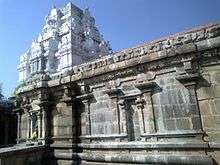Jambai village
| Jambai | |
|---|---|
 Location in Tamil Nadu, India | |
| Location | Villuppuram, India |
| Coordinates | 12°00′52″N 79°03′16″E / 12.014472°N 79.054527°E |
| Type | Cultural |
| State Party |
|
Jambai (Tamil: ஜம்பை) is a 1 km2 village in Tirukkoyilur (Tamil: திருக்கோயிலூர்) taluk in Villuppuram (Tamil: விழுப்புரம் ) district in the Indian state of Tamil Nadu. The major occupation of the people living at this place is agriculture and handloom. In 2011, it had a population of 2,000 people.[1]
Etymology
Jambai got its name from Jambunatheshwarar temple, a Chola period (Shiva) temple. According to the inscriptions present inside the temple, this village was called as Valayur during the Parantaka Chola I period. Hence, "Jambai" might be a later name to this village.
Location
Jambai is located on the northern bank of the river, Thenpennai. It is 19 kilometres (12 mi) northwest of Tirukkoyilur and 25 kilometres (16 mi) south of Thiruvannaamalai.
About the village
Jambai village has more-than-1000-year-old heritage. At Jambai, Saivism, Jainism, Buddhism and Saktism prevailed. In 2006, a beautifully carved 10th century A.D. Buddha sculpture was stolen from the middle of the Fort area paddy field. There are two Siva temples, One Saptamatrika shrine, one Ayynar temple on the hill and other Ayyanar temple in north east corner of the village. Jain Tirthankara relief carving is seen in the hill on the way to Pallichandal. The importance of the village comes from the presence of the Shiva temple called Jambunatheshwarar temple and Jambaimalai containing 1st century B.C.E. Tamil Brahmi inscriptions, Jain abode, caves and beds.
Jambunatheshwarar Temple

In Tamil, this temple is called Thanthondreeswarar temple (Tamil: தான்தோன்றீஸ்வரர் கோயில்). This Shiva temple was built by Cholas during 10th century. The temple walls contain full of Tamil vattezhuttu inscriptions of Cholas. This place was under Rashtrakuta rule during the mid 10th century, the statues of Lord Muruga, Jyestha Devi, Kalabairavar, Durga belonging to Rashtrakuta architecture, are found inside the temple. Since the temple become very old and damaged, reconstruction works are carried by local people of Jambai now.[2]
Jambaimalai

This is a small hillock in the north east of the village. Between a split area of this hillock there are signs of megalithic period settlement. This beautiful hillock contains a cavern called Dasimadam where Tamil Brahmi inscriptions dated 1 B.C is found. The epigraph is in Tamil (except for the title in Prakrit) and reads "Satiyaputo Atiyan Nedumaan Anjji itta Paali". In (Tamil: ஸதியபுதோ அதியந் நெடுமாந் அஞ்சி ஈத்த பாழி).[3] The meaning of the epigraph may be rendered as "The abode (pali) given by (itta) Atiyan Nedumaan Anji (name), the Satyaputra (title)". Though the record is a short one in a single line, it throws valuable light on various aspects of South Indian history. The inscription clears the doubt about the identity of the Satyaputras, a dynasty of rulers, mentioned in Asoka's inscriptions in the 3rd century.[4] Opposite to this cavern, another cave with four Jain stone beds have been found which confirms that Jambai was a Jain centre.[5] West of this hillock in a small stone boulder, a 10th-century C.E. Tamil inscription of Kannaradeva or Krishna III, a Rashtrakuta king, found along with a relief work of Jyestha Devi. South of this inscription a lake for irrigation was constructed.[6]
Pictures
-
Jambaimalai along with lake
-

Jyestha devi
-

jambaimalai hillock
-

Jain cave
-

Jain beds
-

Rock pit used by Jain monks
See also
External links
References
- ↑ http://www.indiamapped.com/tamil-nadu/viluppuram/tirukkoyilur/jambai/
- ↑ K. Selvaraj, "Jambai oru aayvu", State Department of Archeology, Chennai
- ↑ K. Selvaraj, "Jambai oru aayvu", State Department of Archeology, Chennai
- ↑ http://tamilartsacademy.com/books/roman%20karur/chapter13.html
- ↑ D. Ramesh, "Nadunaattu Samanakovilkal" (2nd ed.) Tamilventhan Pathippagam, Ulundurpettai (2005)
- ↑ K. Selvaraj, "Jambai oru aayvu", State Department of Archeology, Chennai